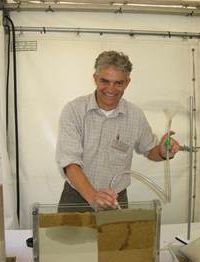Improved water efficiency may not necessarily mean using less water, but it should ensure maximum crop uptake and better yields and quality, said the principal research fellow in irrigation and water resources at Cranfield University. Dr Knox warned that this year’s dry spring may be a foretaste of what is to come in terms of climate change, with growers having to contend with much greater climate variability and uncertainty. 2011 started with a very dry spring, which was later made up by rainfall over the summer. As a result, a number of growers who would not normally irrigate, had to do so this year to maintain tuber quality. Many also irrigated wheat which was very unusual.
“Inefficient irrigation can result in a loss of income in addition to increased production costs, in effect having a double impact on profitability,” said Dr Knox. “Ensuring your water management and scheduling is tailored to your potato variety, and takes into account local soil and climate conditions is key to building a sustainable, profitable business.”
In a typical dry year, more than half the water consumed in potato production can be from irrigation, whereas in wetter years, it can be as low as 16 per cent, according to recent water footprinting research at Cranfield University. “Growers with cultivations over a wide area may have to contend with diverse soil types, with a variety of infiltration properties. Appreciating these differences when devising an irrigation schedule is crucial.”

Jerry Knox demonstrating water movement in soils
In his seminar, Dr Knox also advocated optimising equipment use and crop and soil management via his ‘pathway to efficiency’ in addition to avoiding ‘stretching’ irrigation networks beyond their original peak capacity. Correct operating pressures for efficient irrigation is vital, and growers should monitor pressures at varying points in their distribution system, he said.
“Low pressures are the most common problem – causing poor atomisation, and larger drops that can then damage soil structure. In addition water uniformity may become more uneven, with some areas saturated whilst others remain dry. These non-uniform impacts result in greater differences in tuber size at harvest.”
Long-term implications of climate change will be discussed by Potato Council head of R&D, Dr Mike Storey at BP2011
Dr Mark Stalham from Cambridge University Farm (CUF) declared that potato growers could potentially achieve better seedbeds by working them less. According to research undertaken by CUF funded by Potato Council, soil structure is being destroyed as a consequence of some cultivation techniques used by potato farmers, “De-stoning at different depths can create differences in bulk density, strength and rootability,” emphasised Dr Stalham. “Our results in 2011 have shown that when planting takes place at a similar depth, de-stoning anywhere between 19 and 54 cm does not have any effect on emergence. There has also been little effect on yield to date but more results are to come. “Furthermore, neither ridge shape nor ridge compression affected emergence but soils were dry at planting this spring.”
Drs Knox and Stalham also held practical sessions showing water infiltration through different soil textures and a soil pit to demonstrate effects of destoning depth. Field trials on defoliation methods were also demonstrated at the event.
“This year has seen crops naturally starting to senesce at burndown timing, so choice of product has not been as critical as it would normally be for preventing re-growth,” commented Frontier’s Dr Reuben Morris, who has been conducting research on the effects of applying various products in addition to flailing.
“However, it is crucial that growers time burndown correctly, as tubers are commonly bulking early, coming out bigger than the specified size, and may lead to a lower marketable yield at grading to meet customer specifications,” he warned.
Other field topics covered at the Potato Council event included seed treatments from Bayer, Syngenta and Branston, Alternaria updates and monitoring with UAP, and Biofumigation with Branston. In addition, specialists from Grimme offered top tips to reduce tuber bruising and damage from the topper and harvester.









